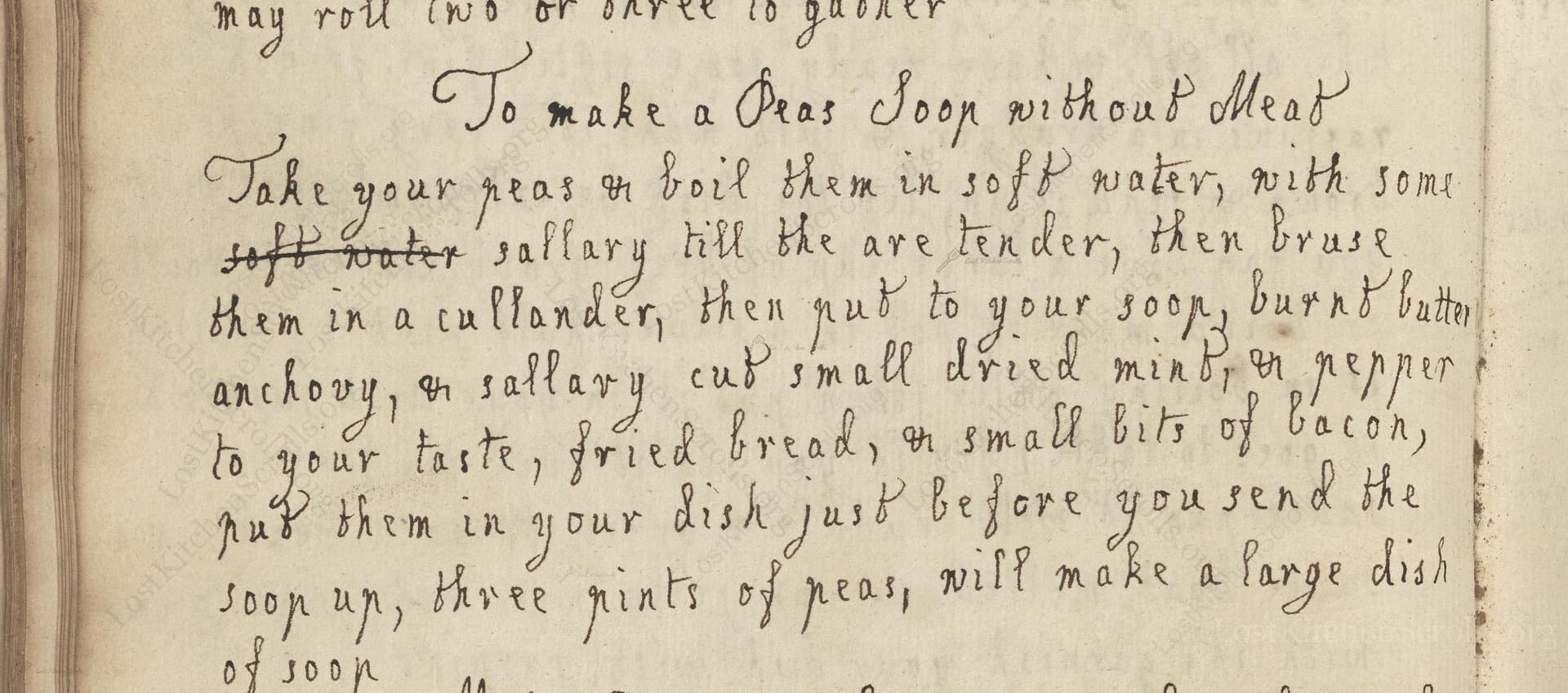To Make A Peas Soop Without Meat
From the treasured pages of Cookbook of 1720
Unknown Author

To Make A Peas Soop Without Meat
"Take your peas & boil them in soft water, with some sallary till the are tender, then bruse them in a cullander, then put to your soop, burnt butterr anchovy, & sallary cut small, dried mint, & pepper to your taste, fried bread, & small bits of bacon, put them in your dish just before you send the soop up, three pints of peas, will make a large dish of soop"
Note on the Original Text
The recipe is written in a straightforward, imperative style, as was typical for the era—providing a sequence of actions rather than precise measurements or times. 'Bruse them in a cullander' would today be 'mash or sieve.' Spelling variants like 'sallary' for celery and 'soop' for soup were common before English spelling became standardized in the late 18th century. The phrase 'send the soop up' refers to bringing the soup to the dining table, a linguistic relic from the formal dining customs of the time. The recipe's structure assumes the reader possesses a degree of culinary knowledge, omitting explicit times or amounts, as recipes were often passed orally or through experience.

Title
Cookbook of 1720 (1720)
You can also click the book image above to peruse the original tome
Writer
Unknown
Era
1720
Publisher
Unknown
Background
Step back to the early 18th century and discover a delightful treasury of recipes and culinary secrets, where traditional flavors meet timeless technique—a feast for curious cooks and history lovers alike.
Kindly made available by
Folger Shakespeare Library
Originating around 1720, this recipe is an excellent example of early 18th-century English cookery, emphasizing economy and adaptability. Meatless soups appeared regularly in both elite and everyday kitchens—sometimes for religious fasting days, sometimes for practicality when meat was scarce or expensive. Celery (then spelled 'sallary') and herbs like dried mint were popular for their aromatic and refreshing qualities, and anchovy was commonly used to provide umami depth in dishes without overtly fishy flavors. Soup was a substantial part of meals for all classes, often served with breads and, if available, a scattering of pork or bacon.

Back in the early 1700s, cooks would use large cast-iron pots or cauldrons placed over open hearths or in the ever-present kitchen fireplace. A cullender (colander) or sieve would have been used to press or bruise the peas, with a pestle or the back of a spoon. Knives and wooden boards for chopping celery and bread, a pan for frying butter and bacon, and a sturdy wooden spoon for stirring would have completed the toolkit. Bread would be fried in a pan with dripping or butter over the coals.
Prep Time
20 mins
Cook Time
45 mins
Servings
6
We've done our best to adapt this historical recipe for modern kitchens, but some details may still need refinement. We warmly welcome feedback from fellow cooks and culinary historians — your insights support the entire community!
Ingredients
- 3.3 lbs green peas (fresh or frozen)
- 2 quarts soft water (filtered or spring water recommended)
- 4–5 stalks celery (2–3 for boiling, 2 for garnish)
- 3 tablespoons unsalted butter
- 2 anchovy fillets (or 1 tbsp anchovy paste)
- 1 teaspoon dried mint
- Black pepper, to taste
- 3.5 oz country-style bread, cut into cubes
- 2 oz bacon, cut into small pieces (optional, can omit for vegetarian version)
Instructions
- Begin by taking roughly 3.3 lbs of fresh or frozen green peas (three pints is about this quantity) and place them in a large pot with about 2 quarts of soft water—filtered or spring water works well.
- Add 2-3 stalks of celery (sallary) and boil until the peas are fully tender.
- Drain the peas, then mash or press them through a sieve or use a blender for a smoother consistency.
- Return the pea purée to the pot, adding the reserved cooking liquid as needed to reach your preferred soup thickness.
- In a separate small pan, make 'burnt butter' by melting 3 tablespoons of unsalted butter and letting it turn golden brown but not black—this imparts a rich, nutty flavor.
- Stir in 2 finely chopped anchovy fillets (or savory anchovy paste), and pour this into the puréed peas along with 2 stalks of celery, finely chopped, a teaspoon of dried mint, and freshly cracked black pepper to taste.
- Simmer gently for 10–15 minutes.
- For garnish, fry cubes of good country bread (about 1/2–3/4 inch in size) in a little oil until crisp.
- If desired, add small cooked bacon pieces, about 2 oz, for extra flavor, scattering both bread and bacon over the soup just before serving.
Estimated Calories
250 per serving
Cooking Estimates
It takes about 20 minutes to prep all the vegetables and ingredients, and around 45 minutes to cook the peas, simmer the soup, and prepare the garnishes. Each serving has about 250 calories. This recipe serves 6 people.
As noted above, we have made our best effort to translate and adapt this historical recipe for modern kitchens, taking into account ingredients nowadays, cooking techniques, measurements, and so on. However, historical recipes often contain assumptions that require interpretation.
We'd love for anyone to help improve these adaptations. Community contributions are highly welcome. If you have suggestions, corrections, or cooking tips based on your experience with this recipe, please share them below.
Join the Discussion
Rate This Recipe
Dietary Preference
Main Ingredients
Culinary Technique
Occasions

Den Bockfisch In Einer Fleisch Suppen Zu Kochen
This recipe hails from a German manuscript cookbook compiled in 1696, a time whe...

Die Grieß Nudlen Zumachen
This recipe comes from a rather mysterious manuscript cookbook, penned anonymous...

Ein Boudain
This recipe comes from an anonymous German-language manuscript cookbook from 169...

Ein Gesaltzen Citroni
This recipe, dating from 1696, comes from an extensive anonymous German cookbook...
Browse our complete collection of time-honored recipes



